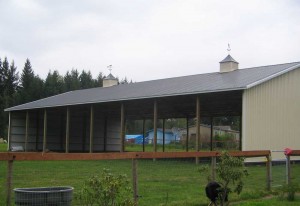Aircrete for Post Frame Cladding
Reader KRISTOPHER in GARDINER writes:
“Can I use pre-cast aircrete panel in lieu of metal siding for the walls and roof?”
Mike the Pole Barn Guru responds:
 It may be possible to use aircrete in lieu of steel roofing and siding, however it would need to be strong enough in bending to span from column-to-column on walls and between trusses on a roof. Product weight would need to be accounted for to adequately design supporting members and attachments could become problematic. All of these considerations could result in some significant investment into engineering costs, perhaps making this system unaffordable.
It may be possible to use aircrete in lieu of steel roofing and siding, however it would need to be strong enough in bending to span from column-to-column on walls and between trusses on a roof. Product weight would need to be accounted for to adequately design supporting members and attachments could become problematic. All of these considerations could result in some significant investment into engineering costs, perhaps making this system unaffordable.
Aircrete is simply concrete with bubbles. Regular concrete we use for our roads, basements, and foundations traditionally is made from Portland cement. This combination hardens into a highly dense material with impressive compressive strength. Addition of iron rebar adds additional structural integrity.
Aircrete reduces or eliminates traditionally used aggregate. Instead of including gravel or other coarse aggregate types, aircrete relies on incorporating premade foam pieces to essentially add bubbles of airspace within a concrete mix. Instead of foam, another option is mixing certain types of reactive substances into a wet cement mix. This chemical reaction creates gas bubbles within a cement and water slurry to harden with empty cavities.
There is no set recipe for aircrete, as exact amounts of foam or air bubbles depend on how aircrete will be used. Generally, aircrete with higher proportions of foam or air bubbles will offer less compressive strength but higher insulation capacities. Builders and homeowners might decide to use some traditional aggregate like gravel in aircrete applications requiring structural strength.
Aircrete offers many traditional concrete benefits with added properties to enhance sustainable and energy-efficient homes. If you have ever been inside an inadequately sealed cement and cinder block home, chances are it felt cold and damp. Aircrete offers superior insulation properties due to foam and air bubbles built into concrete itself.
As with regular concrete, aircrete can be formed into blocks for easy application or poured into forms for walls and other interior and exterior purposes. In one sense, aircrete is similar to ICFs (insulated concrete forms). It increases the insulation capacity of traditional concrete. Unlike ICFs, however, aircrete doesn’t require separate polystyrene foam blocks or other rigid insulation, subsequently connected with space in between for pouring a concrete wall.
Other benefits of aircrete for a sustainable home include:
- Relatively inexpensive
- DIY friendly for innovative homeowners and home builders.
- Good compressive strength
- Self-leveling
- Improved acoustic properties
Aircrete is an innovative approach to “greening up” traditional concrete. However, in some cases, use of aircrete can lead to certain disadvantages. When high densities of foam are included, aircrete can become brittle, and chipping can occur. This type of aircrete will have limited compressive strength and could not be load-bearing.
Homeowners should understand aircrete and concrete are fundamentally different construction materials with different uses. Concrete incorporating natural aggregate has different performance characteristics. Concrete is a great alternative wherever high levels of compressive strength are needed. Where increased insulation is a concern; however, aircrete offers superior advantages.
Aircrete drastically improves upon insulation properties of regular concrete. According to one analysis, aircrete might be able to offer R-6 per inch insulation values. Blown cellulose, for comparison’s sake, only offers R-values of 3.7 per inch. A home built with six inch thick aircrete blocks could potentially achieve an R-value of 36.
Aircrete is also water-resistant and fire-resistant. Portland cement in aircrete offers necessary water resistance. Foam or air bubbles provide an added layer of protection against moisture. Like all cement structures, specific vapor barriers can also help reduce condensation penetrating your home. For homes located in areas where wildfires are an increasing threat, aircrete exteriors can diminish vulnerability and increase overall resiliency.
Aircrete is most often used for exterior and interior walls. However, aircrete can also be used for several other home applications, such as precast blocks and panels and concrete slabs for an insulated flooring system. In some cases aircrete is used for poured roofs, increasing insulation capacity of ceilings and attics where heat tends to escape from homes.
Cost of building with aircrete will depend on several factors, including thickness of application, cost of Portland cement and how much foam aggregate is included. In general, however, aircrete will be much less expensive than building with regular concrete.








aircrete is r=2, unless it is between studs and verrrryyy crumbly. Add chopped styrofoam to it, it will go over r 3, and with stucco can be structural, though i would add wood, steel, or bamboo framing inside the wall. i worked construction and studied architecture for 50 yrs, btw.
Any experience with aircrete?
Not as of yet.